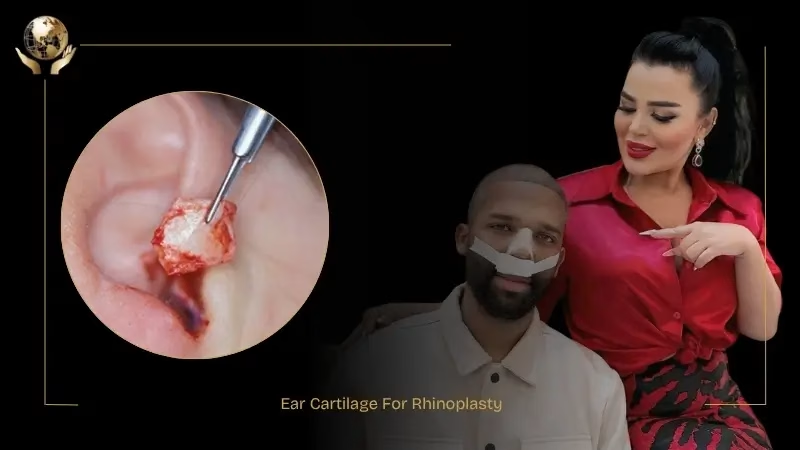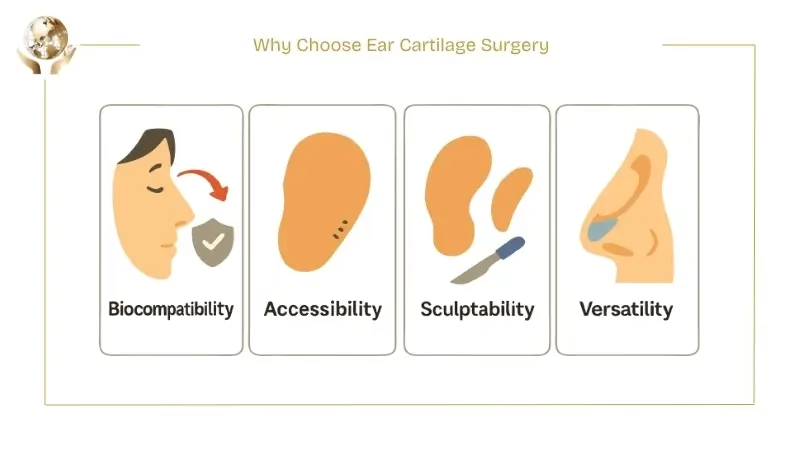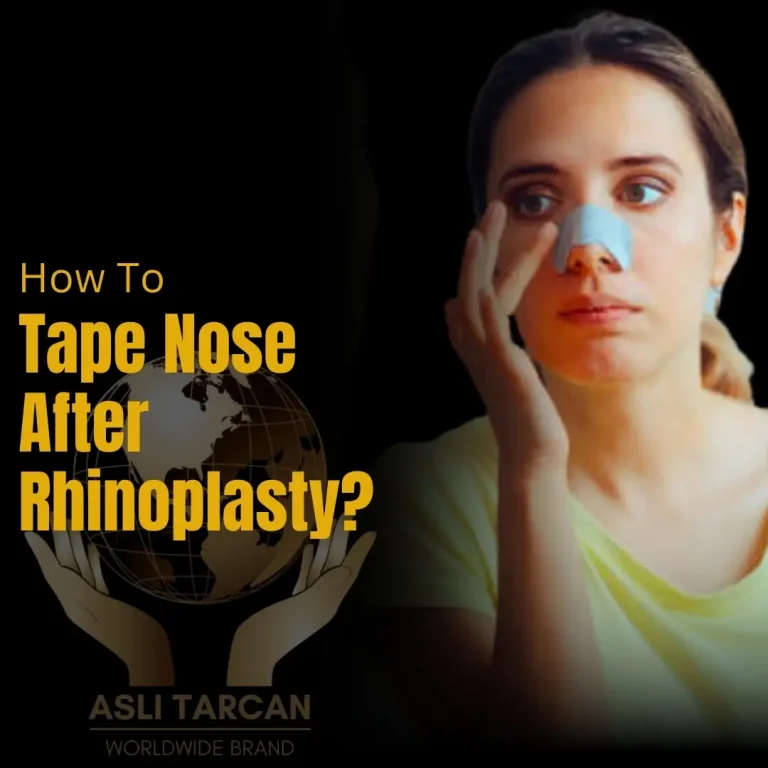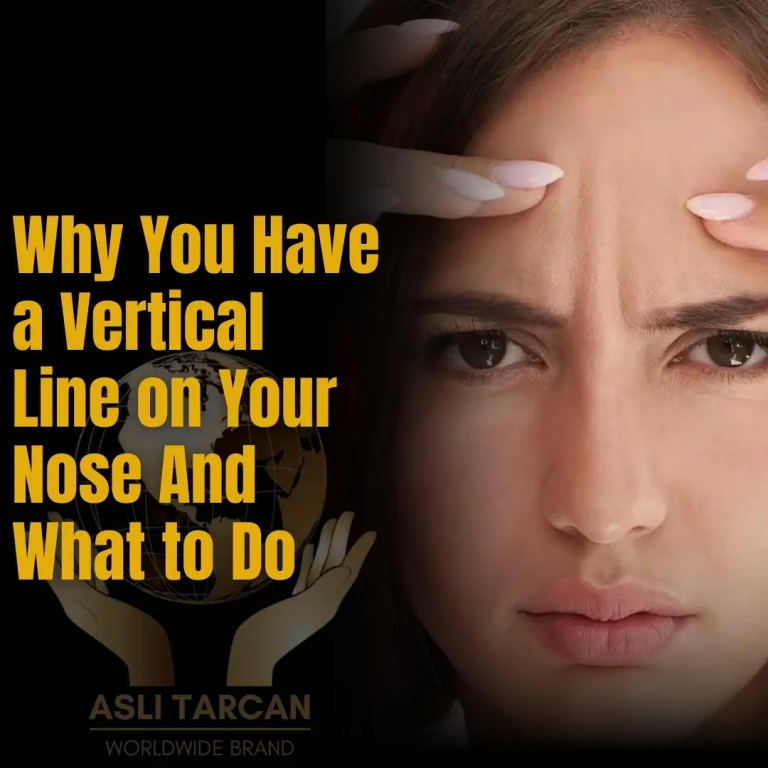Ear Cartilage for Rhinoplasty: Is It Safe and Effective?
Ear cartilage for rhinoplasty is one of the most commonly used rhinoplasty surgery types that reshapes your nose if it has any minor deformities or issues from a previous nose job, and enhances nasal tip projection.
If you’re planning ear cartilage for Rhinoplasty, this guide will tell you everything about it so you can make an informed decision.

What’s Ear Cartilage For Rhinoplasty?
Ear cartilage rhinoplasty is a complex surgery that is done to reshape the person’s nose to make it straight, fill up the gaps, and improve nasal tip projection.
It’s considered one of the safest and easiest types of rhinoplasty, nose Jobs, where the cartilage graft for the nose is harvested from the patient’s ear and used to reshape or reinforce the nose.
The ear donor is convenient and safer for cartilage grafts because rib or septal cartilage has similar quality and doesn’t require such an invasive procedure to harvest the cartilage.
In rhinoplasty, ear cartilage is used in different ways, like to increase the height or the projection of the nasal bridge. The ear cartilage is also harvested to redefine or shape the nasal tip, while providing support to the nasal walls.
The potential advantages of using ear cartilage grafts in rhinoplasty are their customizability and outcome. The ear cartilage is easy to sculpt, according to the patient’s individual needs for shape, structure, and size for a natural look.
The potential downsides to using ear cartilage grafts include ear sensitivity, feeling tender, or discomfort for the patient. Also, the use of ear cartilage grafts can be patients who either have enough cartilage or have already undergone ear surgery.

How Much Does Ear Cartilage Rhinoplasty Cost?
The cost of the ear cartilage for rhinoplasty surgery depends on who’s doing it, how big the cartilage is harvested, and what country you’re from.
Turkey is by far the most affordable to get ear cartilage rhinoplasty surgery compared to other Western countries. It only costs $2,000 to $5,000 in Turkey for a top-class surgery, while in the US, it starts from $5,000 and goes up to $17,500. Even in Australia, it can range from $3,000 to $8,000.
The best thing about Turkey is that it offers various packages that include airport transfers, accommodations, and hospitalization, which reduce the overall cost. Plus, that also gives you the convenience of not managing all these things individually.

What Are The Specific Applications Of Ear Cartilage In Rhinoplasty?
This surgery fixes the following abnormalities with your nose.
- Tip Refinement of Collapsed Nose: Helps lift and support a droopy or weak tip
- Saddle Nose: Fills in the dip from a collapsed nasal bridge
- Asymmetric Nostrils: Balances uneven nostril shapes
- Pinched Nose: Widens and strengthens narrow nasal tips
- Crooked Nose: Adds structure to straighten the nose
- Nasal Valve Collapse: Supports internal airflow and breathing
- Short Nose: Lengthens the nose for better proportions
- Bridge Augmentation: You can consider adding cartilage to the nose for gentle bridge support.
- Previous Rhinoplasty Issues: Repair problems from past nose surgeries
See Also: Pollybeak Deformity After Rhinoplasty

Why Choose Ear Cartilage Surgery
Ear cartilage surgery is a valuable and viable option to choose for rhinoplasty because of its customizability.
Biocompatibility:
It corrects all the deformities left by the previous Nose Job. Usually, it doesn’t cause any infections unless the patient has existing health issues that react with it.
Accessibility:
Harvesting the cartilage from the back of the ear is quite easy compared to the rib or the septal. It also doesn’t leave permanent scars, and they fade sooner.
Sculptability:
Also, it has a natural bend and flexibility that helps shape the tip beautifully.
Versatility:
Ear cartilage can be used along with other graft combinations to achieve the desired aesthetics and functionality. It has a shorter recovery period compared to other types of rhinoplasty.
See Also: Finesse Rhinoplasty
Things To Consider Before Choosing Ear Cartilage For Rhinoplasty
These are the ear cartilage rhinoplasty side effects you must know before choosing it as an option:
- Not strong enough for major nose reshaping or big structure changes.
- It can bend or show through the skin over time.
- It may not be ideal for fixing crooked noses or building a high bridge.
- Might need a second surgery if issues come up.

What’s The Procedure Of Ear Cartilage Rhinoplasty?
When you arrive at Asli Tracan Clinic, discuss the potential risks, your expectations, and goals with the surgeon, and also ask them any questions you have.
Then, the process of ear cartilage surgery usually starts with local anesthesia and an incision in your ear to get the cartilage. The cartilage is then shaped and trimmed to fit your nose perfectly.
Another incision is made on your nostrils, where the cartilage needs to be sculpted and inserted. After that, all the incisions are closed using sutures, splints, and bandages. The process usually lasts for around 2 hours maximum, but this is not fixed as the actual duration is case-specific.
How Should You Prepare For The Surgery?
We at Asli Traan Clinic take a complete history and discuss a thorough plan for preparations.
- Our surgeon lets you know your health history, medications you take already, and the things you are allergic to.
- We recommend you stop smoking at least 6 weeks ahead to help with healing
- Avoid aspirin, ibuprofen, and similar medications, as they can cause bleeding
- Stop any other meds your surgeon tells you to
- Have someone drive you and help out after surgery
- Wear comfy, loose clothes that don’t go over your head
- Don’t eat or drink for 6 hours before unless told otherwise
Know The Risks And Complications Of Ear Cartilage For Rhinoplasty
There are some risks and complications associated with ear cartilage for rhinoplasty.
- Infection may cause swelling or fever
- Some bleeding is normal after surgery
- Scars may fade, but can sometimes stay
- Nose or nostrils might look uneven
- Grafts might shift or not heal well
- Cartilage can slowly fade over time
- Skin color may change near the nose
- The nose or ear may feel numb or odd
- Breathing might feel harder if healing fails
- The donor ear may stay sore briefly
See Also: Asian Rhinoplasty
Asli Tracan Clinic-Your Aesthetic Partner
Rhinoplasty is a Nose Job surgery that reconstructs the nose, fixing its deformities and making it according to the patient’s choice. Ear cartilage for rhinoplasty is one of its types, in which the cartilage is taken from the back of the ear, inserted into the nose, and reconstructed to give you the appearance you desire.
Our surgeons recommend ear cartilage for nose Rhinoplasty as it is safer than other types of rhinoplasty surgeries and also takes less time for recovery and for the procedure itself. You can take it for minor nose adjustments such as lifting the tip, fixing slight asymmetry, or adding gentle support to the bridge.
Ready to discover how ear cartilage rhinoplasty can redefine your looks? Reach out to Asli Tracan Clinic today and take the first step toward the nose you’ve always wanted.
See Also: What Is A Button Nose

This article is medically reviewed by Prof. Dr. Umit Taskin (E.N.T. Surgeon)
See Our Doctors & Surgeons
How long does ear cartilage for rhinoplasty take to recover?
You’ll need around 6 months to fully recover, but the swelling and pain usually go away in a few weeks.
Is otoplasty allowed in Islam?
It’s generally okay if it’s to fix something medical or abnormal, not just for looks.
Is ear cartilage surgery painful?
During surgery, you don’t feel any pain because of anesthesia, but in post-op days, you feel discomfort, tenderness, and some sort of pain.






